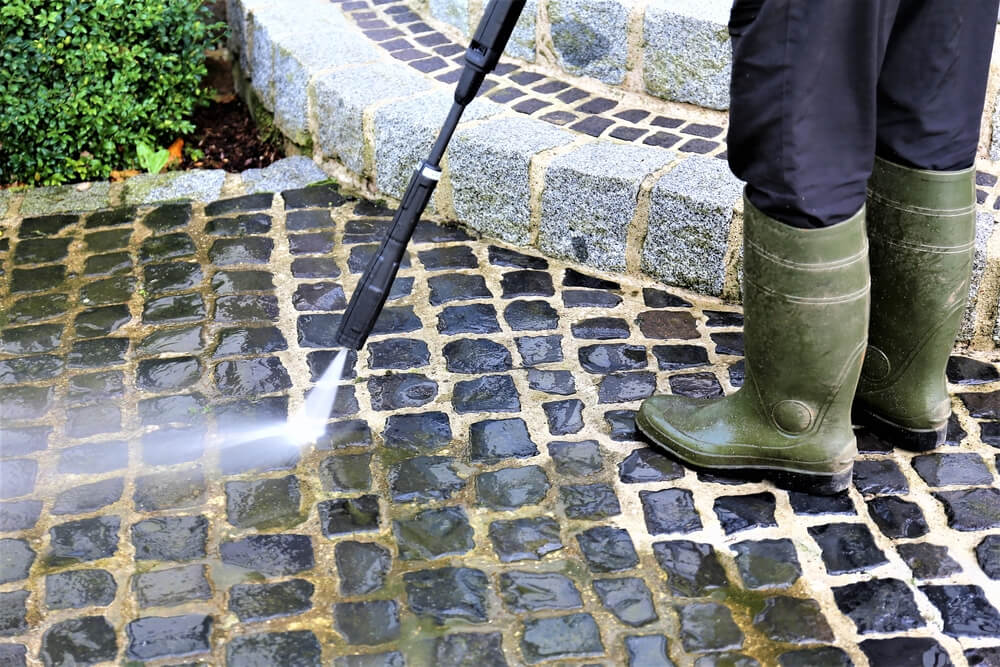Do you know of the benefits of pressure washing? Of course, you do, that is why you are here. But how to go about it…?
Aha!
Well, we will show you, in straightforward steps – the exact way to go about pressure-washing a house.
Vancouver is a very humid city, where it rains any other day. Come summer or fall. It makes perfect sense how mold and mildew can grow so quickly. The high humidity level creates an ideal environment to thrive.
The white, green patches of moss or mildew growing on your patio, walls, or driveway are unpleasant. They become areas where you feel the need to guide visitors away from. Even you dodge them from your field of vision so that they will not upset your mood.
But with the miracle of pressure washing, you can remove those hideous speckles from your home in a few hours, very easily.
In case you don’t know, pressure washing (also called “power washing”) uses a small – but super powerful – machine to create high-pressure water streams that scrape off dirt, dust, mold, soot, or whatever is stuck to a “hard” surface away.
Most people prefer to hire a professional to do pressure washing.
Gear Up!
Four Things You Need for Effective Power Washing
First of all, you need to gather the equipment you will need to carry out your power washing. These include: Protection for yourself, Protection for your surroundings, cleaning agents, and of course, a POWER WASHER!
1. Power Washer:
Let’s begin with the most vital of the lot, which is the power washer. The power washer generates high pressure that is responsible for power cleaning. Hence, one must be available for a power washing activity.
You can either buy one – for a few hundred dollars or rent one for about 50 bucks.
If you have a tall or multi-story house, you should get an extension wand along with the power washer. You will need additional nozzles, as they have let out water at varying angles (which affects the pressure)
2. Cleaning Agents:
Cleaning agents will reduce the amount of time and water pressure you need to apply to get results. A mildewcide is a must for Vancouver residents. Other cleaning agents you will need is a brush, detergent, and bleach.
3. Protection for your surrounding:
Remember, we are working with water here. Water is not very friendly to many household materials, especially one being fired at such high pressure.
You will need to protect your lawn and plants around the siding you are washing with drop cloths—cover electrical outlets, holes, or openings in the walls with duct tape.
4. Protection for Yourself:
Yes! Even you have to be protected. You should know that the pressurized jet of water coming from the power washer can cut through the skin.
So, it would help if you handled it with ultimate care. Heed the following advice:
- Spray from a safe distance
- Put on protective wears: Goggles/eye protection (vital), gloves, and boots
- Clear the area of people, especially children
- Start/Practice with low-pressure nozzles to get a feel of it.
- And please, do not rinse your arms or legs with the pressure washer
How to Clean Your House with a Pressure Washer?
So, you have your pressure washer ready with extension wands and additional nozzles? You have covered your lawn, plants, outlets, and openings? You have cleared the area, and you are dressed up like a carpenter? Good!
You are now ready to rid your house of that ugliness.
Step 1:
Connect the Pressure-washer to a water source using a garden hose. Following instructions from the specific manufacturer of your pressure-washer.
Step 2:
Put the cleaning agents in the dedicated compartment within the washer. If your washer doesn’t have space for it. You will have to mix the detergent/bleach/mildewcide manually with water, which you should then put in a garden spray attached to the washer.
Step 3:
Start the power washer and find an effective distance to start spraying. By effective distance, you want a distance where: You are safe from the debris ricocheting off the walls; The pressure is not damaging the paint or walls, and cleaning is still effective.
Step 4:
Clean your walls one section at a time. You want to clean only a couple of feet at a time. Spray with the detergent/bleach/mildewcide solution first.
Use a higher pressure where necessary. Stand with your feet apart to give you a better balance and prevent falling from the nozzle’s recoil.
Pro tip: Spray from the bottom to the top. Why? To avoid scum from covering areas you have not cleaned.
Step 5:
Rinse your walls/pavement section by section. After spraying with the solution (from the bottom, to the top), you should rinse each section of your wall/pavement with clean water to wash away the dirt and chemicals.
You should hold the wand with both hands to make sure you don’t get water into the underside of the walls (thereby giving the mold and the mildew a place to grow next)
Repeat the process for each section of your house until you have it all covered.
Conclusion
As mentioned earlier, pressure washing a house can be dangerous. If it is not something you feel you can handle, please get a professional to take care of it for you.
Ready to hire professionals to take care of your cleaning needs? AdelCo Home Services is a one-stop-shop cleaning solution for any commercial or residential property owner when it comes to taking care of your building or home. Call us or send us an email to talk to one of our professionals!

